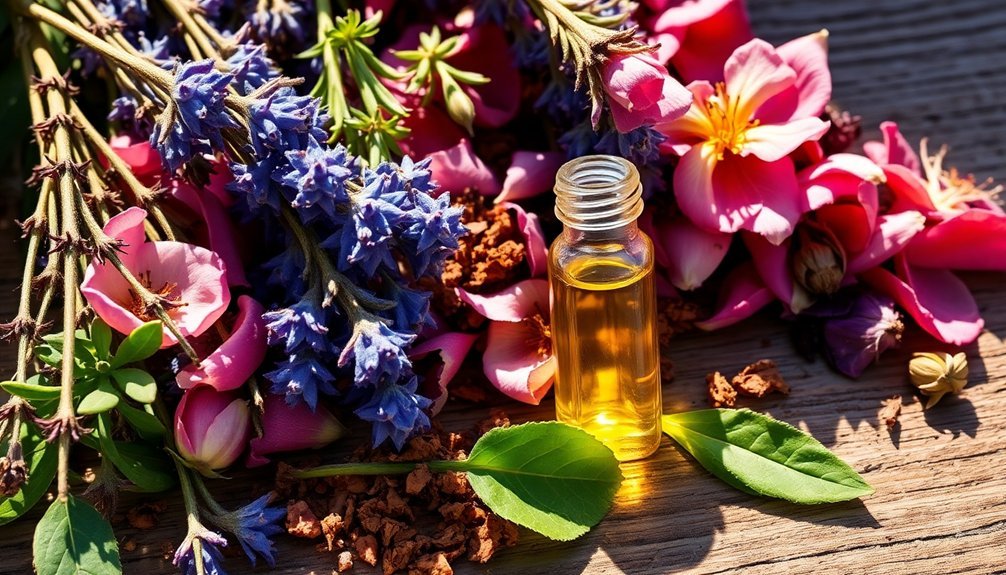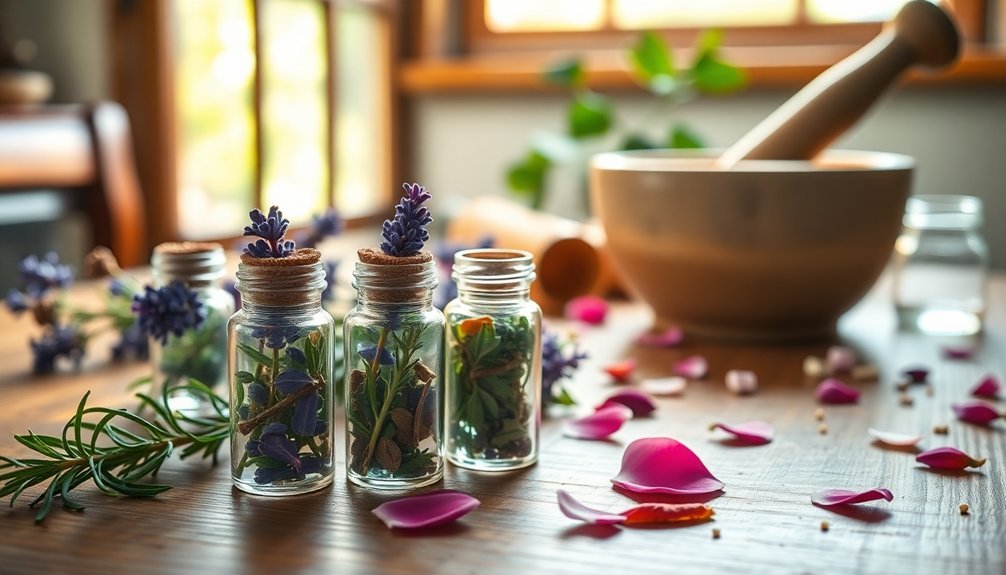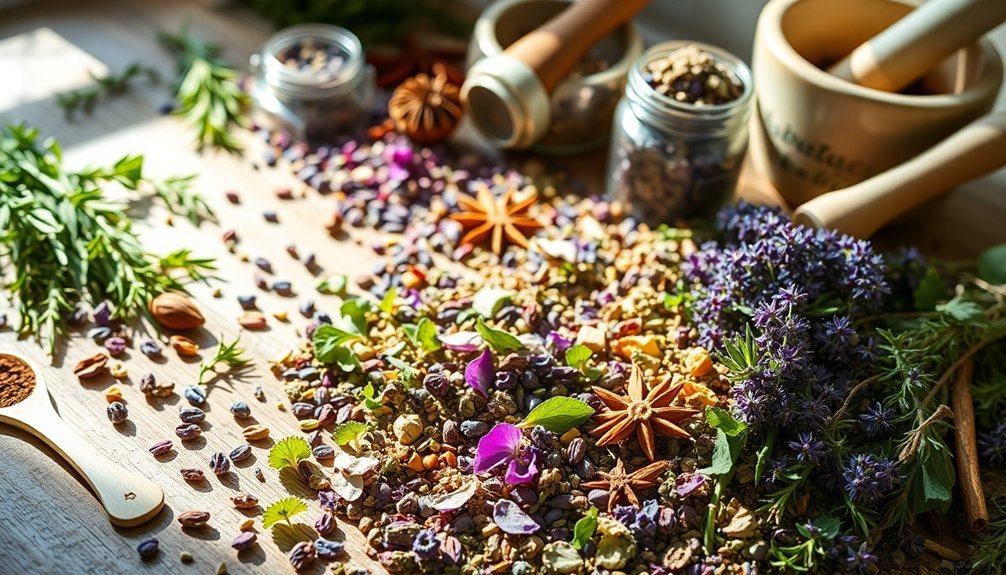To create long-lasting homemade perfumes, you'll want to incorporate natural fixatives like frankincense, vetiver, benzoin, patchouli, and sandalwood. These powerful herbs and resins slow down the evaporation of volatile compounds and help balance your fragrance's vapor pressures. Start with 3-5% fixative concentration in your base notes, adding them drop by drop while maintaining detailed records. Once you've mastered these foundational fixatives, a world of complex, stable fragrances awaits.
Understanding Natural Fixatives in Perfumery

While creating homemade perfumes can be exciting, understanding natural fixatives is essential for achieving long-lasting fragrances.
These substances work by slowing down the evaporation of volatile compounds and balancing vapor pressures, ensuring your scent stays true throughout the day.
You'll find natural fixatives in three main categories: non-volatile fixatives like benzoin and labdanum, sensory fixatives such as patchouli and sandalwood, and exalting fixatives including vanilla and tolu balsam.
Each type serves a unique purpose in your perfume creation. When you're formulating your blend, aim to use fixatives at 3-5% concentration in the base notes. Modern alternatives include synthetic substitutes that are both economical and ethically sourced.
They'll help anchor the fragrance to your skin while interacting with your body's natural chemistry to enhance the overall aroma and longevity of your homemade perfume.
Top 5 Herbal Fixatives for Long-Lasting Scents
Natural fixatives are abundant in the plant world, and certain herbs stand out for their exceptional ability to extend perfume longevity. You'll find these five powerhouse fixatives particularly effective in your homemade perfume creations.
| Fixative | Key Characteristic | Best Used For |
|---|---|---|
| Frankincense | Resinous aroma | Delaying scent loss |
| Vetiver | Clean, lasting scent | Base note stability |
| Benzoin | Warm undertones | Background depth |
For ideal results, you'll want to incorporate patchouli and sandalwood into your blend as well. Patchouli offers an earthy anchor that grounds volatile top notes, while sandalwood's rich, woody profile helps stabilize the entire composition. When using these fixatives, remember to follow the classic 3:2:1 ratio for top, middle, and base notes to achieve a well-balanced, long-lasting fragrance. Double-distilled vetiver's clean and refined aroma makes it an excellent choice for creating elegant signature scents that last.
Proper Blending Techniques With Natural Fixatives

Creating a well-balanced perfume requires mastery of proper blending techniques with natural fixatives.
You'll want to start by selecting one or two fixatives like vetiver, amyris, or benzoin as your foundation. Add these drop by drop while keeping detailed records of your proportions.
When blending, incorporate your fixatives early in the process to enhance stability, but use them sparingly to avoid flattening the scent.
You can then build harmony by adding blenders such as lavender or bergamot to connect different note levels. These help smooth out the composition and create seamless connections between top and heart notes.
Test each addition carefully before moving forward, and don't rush the process. Allow your blend to rest for 48 hours before making final assessments.
Remember that overdoing fixatives can result in a lifeless blend, so it's better to start with less and adjust gradually.
Essential Tools and Measurements for Fixative Use
Four essential tools form the foundation of proper fixative use in perfumery: amber glass bottles, graduated pipettes, a precision scale, and glass stirring rods.
You'll need these tools to guarantee accurate measurements and proper storage of your blends.
When working with fixatives, you'll want to maintain a ratio of 3-5% fixative to your total fragrance composition.
For your perfume structure, stick to either a 3:2:1 or 1:1:1 ratio of base, middle, and top notes.
If you're using absolutes, start with just 0.1-0.5% of your total formula.
For best results, blend your fixatives with fragrance oils first, then incorporate them into your perfume base.
Let your creation mature for several weeks in a cool place to develop its full character and longevity.
Creating Your First Herbal Fixative Blend

With your tools and measurements ready, you'll want to begin with a simple yet effective herbal fixative blend.
Start by combining sandalwood and patchouli as your foundation, using 3% of your total perfume volume. These two fixatives work synergistically to provide both stability and rich base notes.
Add a small amount of frankincense (1%) to introduce a spicy, piney element that helps bind the fragrance together.
If you're seeking additional depth, incorporate either benzoin or labdanum at 1% – both offer sweet, warm undertones that enhance longevity.
Remember to layer your fixatives carefully, allowing each to blend naturally with your other perfume ingredients.
Keep track of your ratios, as they'll determine how well your fragrance maintains its integrity over time.
Frequently Asked Questions
Can I Use Dried Herbs Instead of Essential Oils as Fixatives?
While you can use dried herbs, they're not as effective as essential oils for fixing fragrances. You'll get better results using traditional fixatives like benzoin, frankincense, or myrrh in your perfume blends.
How Long Should I Age My Perfume After Adding Herbal Fixatives?
You'll need to age your perfume for at least 2-3 weeks after adding herbal fixatives. For complex blends or dried herbs, wait up to 6 weeks to allow the scents to fully mature and stabilize.
Are Herbal Fixatives Safe for Sensitive Skin Types?
While herbal fixatives can be safe, you'll need to patch test first. Use diluted concentrations and stick to gentler options like frankincense or clary sage. Avoid rosemary if you're sensitive to botanical ingredients.
Do Herbal Fixatives Change Color or Darken Over Time?
No, you won't notice color changes with most herbal fixatives. When properly stored, they maintain their original appearance over time. Any darkening you see is likely due to environmental factors, not the fixatives themselves.
Can I Combine Multiple Herbal Fixatives in a Single Perfume Blend?
Yes, you can combine multiple herbal fixatives in your blend. It's beneficial to mix them, as they'll work together to enhance longevity, add complexity, and create a more balanced fragrance profile.
In Summary
Now you're ready to create your own signature perfumes with lasting power. Start with small batches using these natural herbal fixatives, and don't forget to keep detailed notes of your successful blends. You'll find that orris root, myrrh, and vetiver make excellent starting points for your perfume-making journey. With practice and patience, you'll soon master the art of crafting long-lasting natural fragrances that rival commercial perfumes.





Leave a Reply